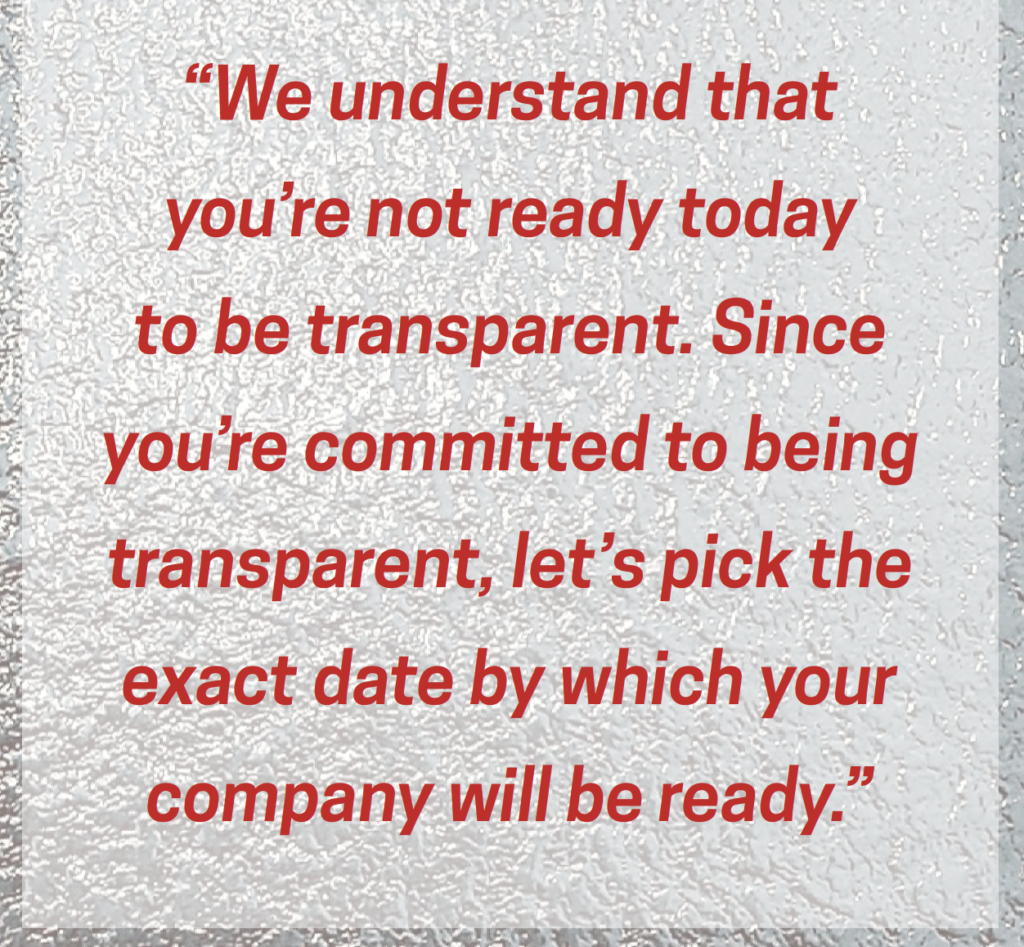Please enter your email in order to download this publication.
By Marc Effron, President, Talent Strategy Group
Transparency about performance and potential remains an incredibly important topic with our clients around the globe. We are asked about it in our consulting engagements, courses and client conversations.
Yet, we find that the frequency of these discussions is not correlated with a meaningful increase in transparency. Companies’ commitment to be transparent with their employees about their performance, behaviors and ability to advance remains far below what we believe is needed.
We recognize that creating a more transparent culture requires effort, sustained commitment and having long-delayed, difficult conversations. Despite those challenges, we believe that most companies should be ready (and are ready) to be far more transparent about potential and performance.
The Three Excuses
When we speak with companies about their journey to transparency, we normally hear one of three statements about why they are not transparent today. We believe that each statement is more excuse than reason and that the objections in each statement can easily be overcome. Those statements are:
Excuse #1: If we tell some people they have high potential, it will disengage everyone else.
This excuse assumes that there is only one “prize” in the organization – being a high potential leader. By default, this places every other employee in the category of “not high potential,” which we acknowledge would be a disengaging situation for them.
In reality, companies are not that binary in how they recognize and reward employees. There is always some differentiation by contribution level, but most companies cannot crisply communicate the “prize” for different levels of performance and potential.

For example, what does your company offer to leaders who are consistent high performers but do not have high potential to advance? These individuals may be technical or functional experts who have reached their ultimate role in the organization but continue to perform at a very strong level. How do you pay them? What experiences do they get? What projects are they assigned to?
To overcome this excuse, organizations need to define what prizes they give for various levels of employee contribution. Start by categorizing all of the investments you can make in your employees including experiences, projects, exposure to senior executives, development courses, coaching, etc. Then, decide how you will allocate those investments across different levels of performance and potential. My recent article “A Prize in Every Box” explains in detail how to do this.
Once you have decided what the prize is for each level of contribution, help both employees and people managers understand how to have a productive discussion about it. Simple tools like the Talent Investment Grid can give structure to this conversation.
The true benefit from clarifying the prize at each level is that employees better understand the link between their contributions and the investment that the company is willing to make in them.
Some people will be unhappy about the prize they get. That’s OK. That reaction encourages a transparent conversation with their manager about the employee’s current contribution and how they can elevate their contribution to earn a different prize.
Excuse #2: If we tell a high potential that they have high potential, they will either get a large ego, behave badly and/or leave the organization.
This seems like an odd outcome if your company has accurately identified leaders who have high potential to advance. In case this is on your list of concerns, however, you can address it in a very straightforward way.
When you communicate the prize to a high potential leader, balance the conversation so that it highlights the benefits of that designation along with the responsibilities that come with it. A well-balanced conversation may sound like this:
“Congratulations, Susie. As you know, we have talent reviews twice a year here at XYZ Corporation. We conduct those to help understand our leaders’ ability to move upward into positions of greater responsibility.
In our most recent discussion, the executive team agreed that you have the potential to contribute in an even more meaningful way. There was alignment that your capabilities and your leadership behaviors fit well with our future challenges. We want to make sure you have every opportunity to demonstrate your potential.
To support your growth, we will be investing in you in a variety of ways including assigning you an executive coach, giving you exposure to key executives and projects, having you participate in a special high potential program, and more. We hope you find these investments valuable and that they have the desired effect of accelerating your development.
It’s also important for you to remember a few important points about being a high potential leader here at XYZ. We conduct talent reviews every six months and we use those conversations to assess whether leaders are advancing at the pace that we believe indicates high potential.
We certainly hope that you remain a high potential leader for many years. But people change and XYZ’s needs change. Those changes could shift our assessment of you. Therefore, please don’t consider this to be a permanent designation but one that you are continually re-earning.
Second, we often ask our high potential leaders to contribute even more time to the organization. You were already working hard and delivering great results. We may now ask you to make a geographic move, lead a large special project or contribute in other ways that we believe will enhance your development.
Finally, being a high potential leader here at XYZ is somewhat like being on the Broadway theater stage compared to the regional theater stage. The lights are hotter, the audiences more demanding, and the critics meaner. If you trip on stage, everyone is going to see it and judge you by that.”

A structured conversation ensures that the high potential appreciates the investment that will be made in her and the challenges that come with the new designation.
The other concern we sometimes hear is that once a leader is told they have high potential, they will look for opportunities outside their organization. We are not sure why an employee would run for the door after they’ve been told how much the company values them and plans to invest in them. I would suggest this is more of an excuse than it is a legitimate reason not to be transparent.
Excuse #3: We’re not ready.
This may be a valid excuse – for today. Our response is simple and direct when we hear clients say this: “We understand that you’re not ready today. Since you’re committed to being transparent, let’s pick the exact date by which your company will be ready. Let’s say that it’s one year from today. That will allow us to create a project plan and work backwards from that date to ensure everything is ready.”
That response forces one of two conversations. If the executives never truly believed in being transparent and were using “not ready” as an excuse, it allows a more transparent discussion about their actual talent philosophy. If they genuinely believed that they weren’t adequately prepared, setting a transparency “go live” date provides both certainty and pressure to execute a plan by that date.

The Only Legitimate Excuse
There is one legitimate reason not to be transparent with your employees about their performance and potential. If you genuinely believe that your assessment of performance or potential is inaccurate, then you should not be transparent with this data. This is a problem to be solved, however, not a permanent excuse to not be transparent.
Give your company six months to create and implement a more accurate assessment process whether that means improving the facilitation of your talent reviews, better defining potential or clarifying your performance-differentiating behaviors. Once those elements are in place, you’re ready to be transparent.
Be Transparent Now
The conversation about transparency is really a conversation about maturity. By not communicating to employees where they stand in the organization, you are treating them like children. You are saying that they are not able to understand or to process this information in order to make informed decisions about their own actions and career.
We would suggest that is not true, and that despite the difficulty in having some of these conversations, transparency is the minimum level of respect we owe to our team members.
Marshall Goldsmith once helpfully explained that transparency does not equal total disclosure. Applying that wisdom here, we are not suggesting that you immediately share with every employee every fact, thought and feeling you have about them. Discretion is still a valuable commodity but it’s not an excuse to lie, shade the truth or obfuscate relevant information about an employee’s future.
The wonderful thing about becoming more transparent is that you can do it, literally, now. After reading this article you can have a more transparent conversation with your direct reports, your peer or your boss. It’s your choice if you want to do this, but there are no obstacles in your way except your fear of having that conversation.
We sometimes advise our clients that there is no right answer to the question of how transparent your company should be. However, for the sake of transparency we will be more direct. More transparency now is the right answer.

More About The Author:
- Marc Effron, President, Talent Strategy Group
- Marc founded and leads The Talent Strategy Group and consults globally to the world’s largest and most successful corporations. He co-founded the Talent Management Institute and created and publishes TalentQ magazine. He co-authored the Harvard Business Review Publishing best-seller One Page Talent Management and 8 Steps to High Performance.
